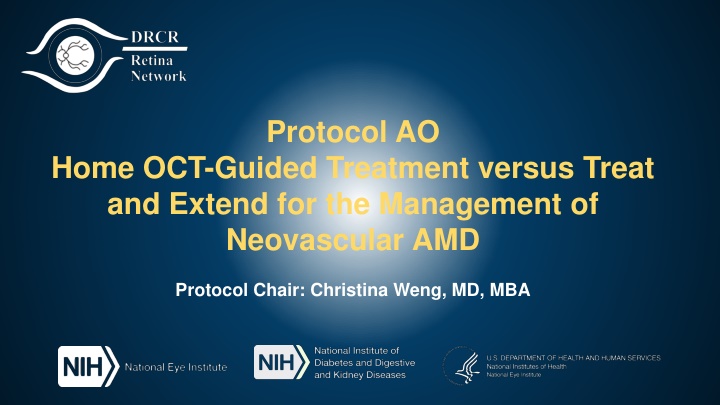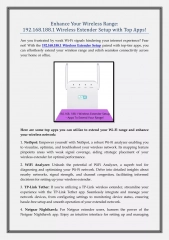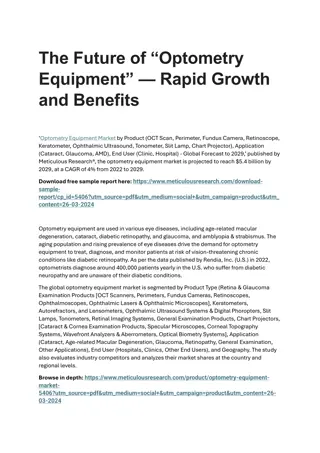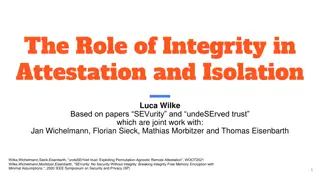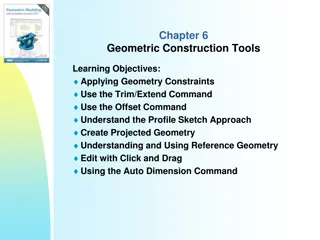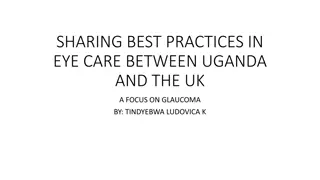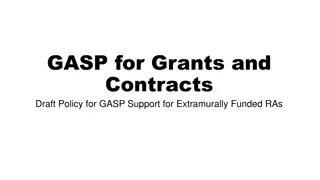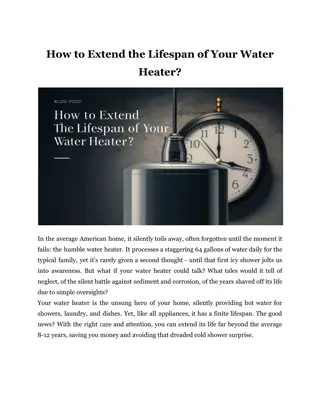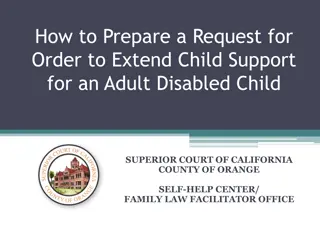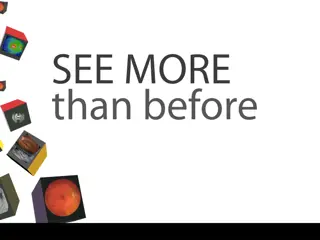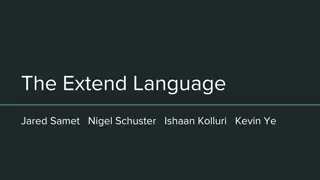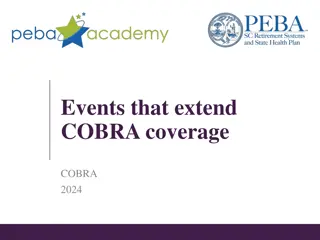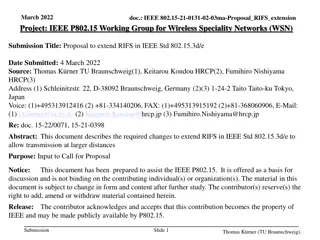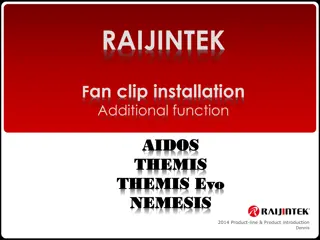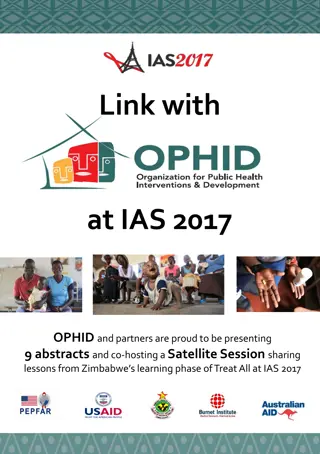Home OCT vs. Treat & Extend for Neovascular AMD Management
This protocol compares the effectiveness of Home OCT-guided treatment with the Treat and Extend approach for neovascular AMD. The study aims to reduce treatment burden while maintaining vision and efficacy, utilizing Notal Home OCT for daily monitoring. A randomized clinical trial will evaluate outcomes in 600 eyes from 80 sites, assessing visual acuity and injection frequency over 104 weeks.
Download Presentation

Please find below an Image/Link to download the presentation.
The content on the website is provided AS IS for your information and personal use only. It may not be sold, licensed, or shared on other websites without obtaining consent from the author.If you encounter any issues during the download, it is possible that the publisher has removed the file from their server.
You are allowed to download the files provided on this website for personal or commercial use, subject to the condition that they are used lawfully. All files are the property of their respective owners.
The content on the website is provided AS IS for your information and personal use only. It may not be sold, licensed, or shared on other websites without obtaining consent from the author.
E N D
Presentation Transcript
Protocol AO Home OCT-Guided Treatment versus Treat and Extend for the Management of Neovascular AMD Protocol Chair: Christina Weng, MD, MBA
Background Treatment of nAMD with anti-VEGF is highly effective but is associated with considerable treatment burden and cost for patients and healthcare systems Optimal timing and the number of injections needed to achieve best visual acuity and disease control for each patient is unknown Innovations are needed to reduce the burden of anti-VEGF injections and monitoring while still maintaining vision and treatment efficacy 2
Notal Home OCT Designed for technician-free operation in the home setting Allows daily disease activity monitoring and the possibility of a tailored and more personalized approach to managing nAMD Notal Vision provides Home OCT device, data analytics and compliance monitoring 3
Notal Home OCT Patients Acquire Daily OCT Scans 3 mm, 88 B-scans 3 mm, 88 B-scans 3 mm, 88 B-scans 3 mm, 500 A-scans 3 mm, 500 A-scans 3-mm, 500 A-scans AI detects fluids, provides quantified spatial fluid maps Total volume for each day is mapped to fluid volume trajectory days
Summary of Rationale A large randomized trial is needed to determine the role of Home OCT in clinical practice This trial will also provide guidance for using Home OCT Setting fluid thresholds Rules for bringing participants into the office for assessment It is important to understand visual acuity outcomes and visit and injection frequencies using a Home OCT-guided treatment strategy versus Treat and Extend (T&E), the most common regimen used in clinical practice 5
Protocol AO: Home OCT vs. T&E Multi-Center Randomized Clinical Trial 600 Eyes from 80 Sites Inclusion Criteria: Age 50 years Best corrected E-ETDRS VA 24 letters (20/320 or better) Active MNV lesion (IRF or SRF in center 3x3 mm on OCT) secondary to AMD 1 drusen (>63 microns) in either eye OR late AMD (MNV or macular atrophy) in the other eye All eyes will receive Faricimab Home OCT-Guided Treatment Treat and Extend Co-primary outcomes: Superiority comparison of mean change in visual acuity and number of injections from baseline to 104 weeks 6
Objectives Primary Determine if Home OCT results in 1) better visual acuity outcomes and/or 2) fewer number of injections over 104 weeks compared with T&E Secondary Compare the number of visits Compare the rates of development of fibrosis and of macular atrophy Understand fluid dynamics in the retina (Home OCT group) Understand the distribution of injection intervals Compare participant- and site-reported outcomes related to treatment and monitoring burden Compare cost over 2 years 7
Major Criteria Able and willing to perform daily Home OCT for 2 years without significant interruption (such as travel >14 days) Prior treatment for MNV Prior treatment with anti-VEGF Treatment with intravitreal corticosteroids within 6 months Successful completion of at least one self-scanning session on the Home OCT device located at the enrolling clinical site Condition that may preclude adequate imaging of the macula MNV due to other causes 8
Ancillary Study Based on CATT and other studies: 50-75% of patients at baseline will have unilateral disease Risk of fellow eye conversion to exudative disease is 10% per year Fellow eyes at risk will be followed with multimodal imaging (including OCTA) to: Describe the incidence and prevalence of non-exudative CNV and the rate of progression to exudative disease Compare time to diagnosis of nAMD, visual acuity when diagnosed, and 2-year vision and imaging outcomes between groups 9
Ancillary Study Major inclusion for fellow eye ancillary study: VA 24 letters (20/320 or better) No current nAMD No prior anti-VEGF injection or macular laser No condition that may preclude adequate imaging of the macula If the above criteria are not met, the participant may still be eligible for the main study and will not have the other eye followed as part of the fellow eye ancillary study. 10
Visit Procedures Procedure (both eyes unless otherwise specified) Treatment Assessment Visits 52- and 104-Week Visits Baseline Visit Visual acuity Low luminance visual acuity Eye exam (including IOP) OCT X X X X X X X X X X X FA Fundus Photography X X X X Anti-VEGF injection per protocol X X X FAF if site has machine X X Fellow eye in ancillary study only (every 3-4 months until eye converts to nAMD) OCTA if site has machine Both eyes Both eyes 11
Baseline Testing Procedures Pregnancy test if applicable An in-clinic pregnancy test is required at baseline for women of childbearing potential to confirm participant is not pregnant prior to injection Pregnancy tests during follow-up will be at investigator s discretion Test session on in-office Home OCT device - study eye only Scans will be uploaded to Notal Vision to review quality Site will receive an email with eligibility determination within one business day Anti-VEGF injection Performed on the day of the baseline visit (prior to randomization) 12
Randomization Must be done within 10 days of baseline visit Can only occur after: Study eye receives study faricimab injection and investigator confirms there are no contraindications for additional faricimab injections Notal confirms the quality of practice Home OCT scans Site calls the participant to confirm they are still willing to participate and obtain daily Home OCT scans if required 13
1 Month Safety Visit for Screen Failures Participants that receive the initial injection of faricimab but are not eligible for the randomization phase (or change their mind about participating) will be asked to complete a one-month safety visit 14
Visit Schedule Required visits for both groups 52 weeks 104 weeks All other visits occur according to the treatment algorithm 15
T&E Protocol Overview Start with monthly injections until disease activity is stable Disease activity = IRF, SRF, or sub-macular hemorrhage When stable (inactive), increase by 2-week increments to a maximum of 18 weeks until recurrent disease activity is observed 16
T&E Protocol Overview When recurrent disease activity is observed: Decrease 2 weeks if the interval was 6 or 8 weeks If interval was 10 weeks: Decrease by 4 weeks if no fluid at prior visit Decrease by 2 weeks if fluid at prior visit Return to monthly injections if significant sub-macular hemorrhage occurs (maintain until resolved) 17
T&E Protocol Overview a = Lowest possible frequency is every 4 weeks b = At the third recurrence of disease activity, the last interval at which the disease was stable should be selected and maintained. If recurrent disease activity occurs again, then the treatment frequency can be reduced by the same rules as the first and second recurrence of disease activity until disease activity is stable (4-week minimum). This treatment frequency would then be maintained for the duration of the study. 18
Home OCT Protocol Overview Participant receives initial injection and followed with Home OCT Investigator performs monthly Home OCT reviews for safety Participant returns for in-office treatment assessment if 21 days since last injection AND one of the following occurs: Three consecutive scans over TRF threshold, or One event 10 nL over the TRF threshold *Threshold is set to 10 nL unless increased for pseudofluid In-office treatment assessment must occur within 1 week after fluid threshold is met All treatment decisions based solely on in-office OCT 19
Home OCT Summary of Clinic Actions Fluid on in-office OCT Action True fluid (IRF, SRF) or sub- macular hemorrhage Give injection and record in viewer No true fluid or sub-macular hemorrhage Do not inject If true fluid also present, give injection and record in viewer If increase for pseudofluid criteria met, increase the total retinal fluid threshold accordingly Pseudofluid present Give injection and record in viewer Participant will return for monthly injections until sub-macular hemorrhage is resolved Significant sub-macular hemorrhage present 20
Home OCT Compliance Compliance will be closely monitored by Notal Vision Patient engagement specialist will call the participant on the third business day following two days without a scan Notal will notify Coordinating Center and site of 7 days without good quality scan Participants that discontinue Home OCT will continue follow-up according to a Treat and Extend schedule 21
Thank You 22
